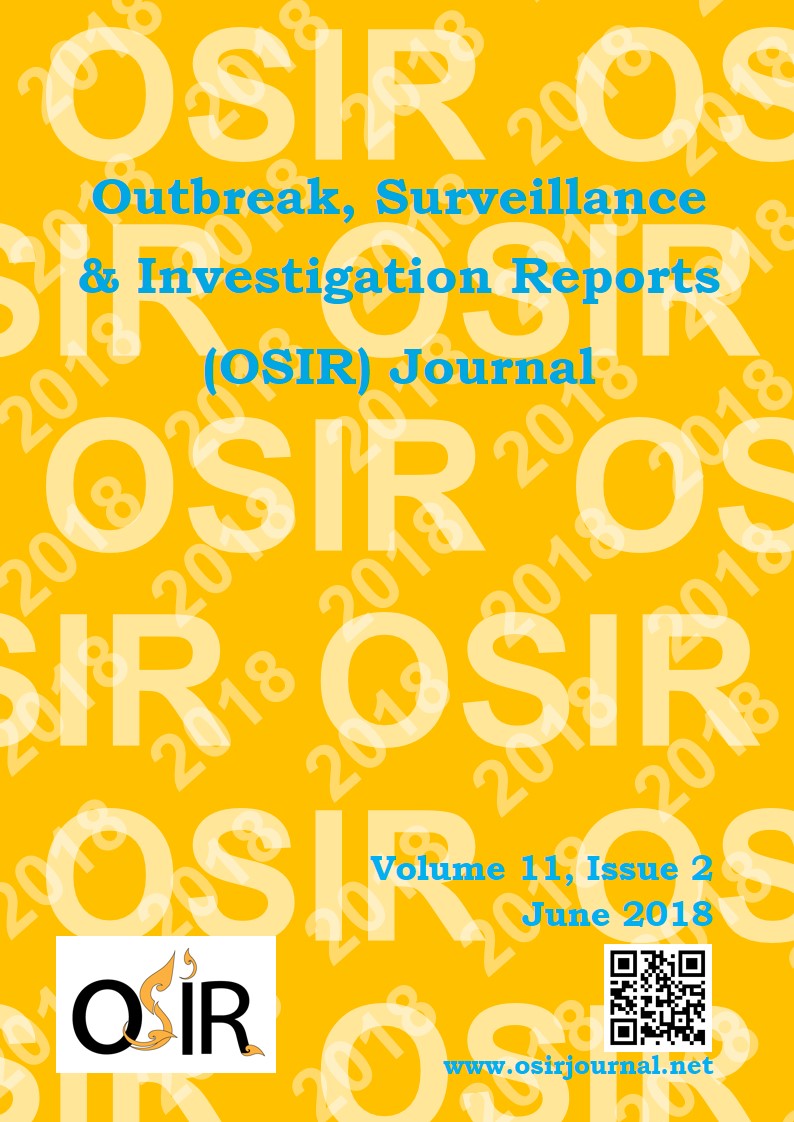Non-pharmaceutical Control Measures in Response to a Large Cluster of Influenza A(H3N2) in a Workplace, Northeastern Thailand, August-September 2015
DOI:
https://doi.org/10.59096/osir.v11i2.263059Keywords:
influenza outbreak, non-pharmacological intervention, control measures, work-related infectionAbstract
The study reports on an epidemiological investigation of an influenza A(H3N2) outbreak which occurred in a manufacturing company in Thailand during September 2015. The workplace consisted of three buildings. Employees in building 1 did not wear protective equipment and masks while those in buildings 2 and 3 wore C-level suit for protection from chemicals inhalation. The disease spread and involved 216 (8.4%) cases from a total of 2,585 employees. Nine out of 18 throat swab samples were found to have influenza A(H3N2) virus. Influenza illness mostly occurred in building 1, with attack rate of 22%. The investigation revealed that the first case possibly contacted the disease from a family member and spread it among employees through direct contact with clinically active cases, and sharing of hand towels in the company toilets. The study emphasized practical control measures, particularly in health education and strong policy regulations in the workplace. It enforced all employees in building 1 to wear masks which lead to the successful control of the outbreak within 10 days without using oseltamivir post-exposure prophylaxis. The event-based surveillance system should be implemented in every workplace for outbreak detection as well as for rapid response.
References
Lenee B, Krista K, Sophie S, Desiree M, Craig S, Brendan F, et al. Update: influenza activity - United States and worldwide, May 24 -September 5, 2015. MMWR. 2015 Sep 18; 64(36):1011-6.1 [cited 2017 Feb 10]. <https://www.cdc.gov/mmwr/preview/mmwrhtml/mm6436a4.htm>
Fiore AE, Shay DK, Broder K, Iskander JK, Uyeki TM, Mootrey G, et al. Prevention and control of influenza: recommendations of the Advisory Committee on Immunization Practices (ACIP), 2008. MMWR Recomm Rep. 2008 Aug 8;57(RR-7):1-60.
Centers for Disease Control and Prevention. People at high risk of developing flu-related complications. 2016 [cited 2017 Feb 13]. <http://www.cdc.gov/flu/about/disease/high_risk.htm>
United States. Occupational Safety and Health Administration. Department of Labor. Guidance on preparing workplaces for an influenza pandemic. 2009 [cited 2017 Feb 12]. <https://www.osha.gov/Publications/OSHA3327pandemic.pdf>
Kuttiyawithayakoon S, Pruankratoke U, Mungaomrlang A. Strengthening of occupational health surveillance and prevention system using social enterprise concept. Journal of Health Science. 2014(23):719-29. Thai [cited 2017 Feb 15]. <http://thailand.digitaljournals.org/tdj/index.php/JHS/article/view/738>
Centers for Disease Control and Prevention. Protective clothing and ensembles. 2014 Dec 12 [cited 2017 Feb 15]. <https://www.cdc.gov/niosh/topics/protclothing/default.html>
Owusu JT, Prapasiri P, Ditsungnoen D, Leetongin G, Yoocharoen P, Rattanayot J, et al. Seasonal influenza vaccine coverage among high-risk populations in Thailand, 2010-2012. Vaccine. 2015 Jan 29;33(5):742-7.
Centers for Disease Control and Prevention. Influenza antiviral medications: summary for clinicians. 2017 [cited 2017 Feb 13]. <https://www.cdc.gov/flu/professionals/antivirals/summary-clinicians.htmtm>
Fiore AE, Fry A, Shay D, Gubareva L, Bresee JS, Uyeki TM. Antiviral agents for the treatment and chemoprophylaxis of influenza --- recommendations of the Advisory Committee on Immunization Practices (ACIP). MMWR Recomm Rep. 2011 Jan 21;60(1):1-24.
Jefferson T, Jones MA, Doshi P, Del Mar CB, Hama R, Thompson MJ, et al. Neuraminidase inhibitors for preventing and treating influenza in healthy adults and children. Cochrane Database Syst Rev. 2014 Apr 10;(4):CD008965.
Heneghan CJ, Onakpoya I, Jones MA, Doshi P, Del Mar CB, Hama R, et al. Neuraminidase inhibitors for influenza: a systematic review and meta-analysis of regulatory and mortality data. Health Technol Assess. 2016 May;20(42):1-242.
Rainwater-Lovett K, Chun K, Lessler J. Influenza outbreak control practices and the effectiveness of interventions in long-term care facilities: a systematic review. Influenza Other Respir Viruses.2014 Jan (8):74-82.
Gorišek Miksić N, Uršič T, Simonović Z, Lusa L, Lobnik Rojko P, Petrovec M, et al. Oseltamivir prophylaxis in controlling influenza outbreak in nursing homes: a comparison between three different approaches. Infection. 2015 Feb;43(1):73-81. Epub 2014 Nov 18.
Sonthichai C, Iamsirithaworn S, Cummings DAT, Shokekird P, Khumket S, Niramitsantipong A, et al. Effectiveness of non-pharmaceutical interventions in controlling an influenza A outbreak in a school, Thailand, November 2007. OSIR. 2011 Dec (4):6-11.
Preziosi P, Czernichow S, Gehanno P, Hercberg S. Workplace air-conditioning and health services attendance among French middle-aged women: a prospective cohort study. Int J Epidemiol. 2004 Oct;33(5):1120-3.
Mendell MJ. Commentary: air conditioning as a risk for increased use of health services. Int J Epidemiol. 2004 Oct;33(5):1123-6. Epub 2004 Aug 19.
World Health Organization. A guide to establishing event-based surveillance. Geneva: World Health Organization; 2008.
Roy MJ, Donaldson C, Baker R, Kay A. Social enterprise: new pathways to health and well-being? J Public Health Policy. 2013 Jan;34(1):55-68.
Downloads
Published
How to Cite
Issue
Section
License
Copyright (c) 2023 Outbreak, Surveillance, Investigation & Response (OSIR) Journal

This work is licensed under a Creative Commons Attribution-NonCommercial-NoDerivatives 4.0 International License.









